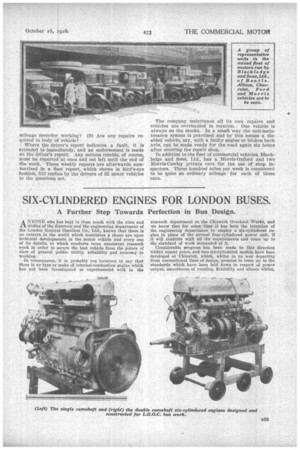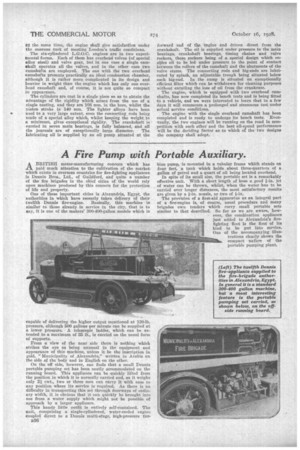SIX-CYLINDERED ENGINES FOR LONDON BUSES.
Page 19

Page 20

If you've noticed an error in this article please click here to report it so we can fix it.
A Further Step Towards Perfection in Bus Design.
ANYONE who has kept in close touch with the aims and wishes of the directors and the engineering department of ,the London General Omnibus Co., Ltd., knows that there is no concern in the world which maintains a closer eye upon technical developments in the motor vehicle and every one of its details, or which conducts more consistent research work in order to secure the beat vehicle from the points of view of general public utility, reliability and economy in working.
In consequence, it is probably not incorrect to say that there is no type or make of internal-combustion engine which has not been investigated or experimented with in the research department at the Chiswick Overhaul Works, and we know that for some time it has been the intention of the engineering department to employ a six-cylindered engine in place of the normal four-cylindered power unit, if it will. conform with all the requirements and come up to the standard of work demanded of it Considerable progress has been made in this direction within recent years, and two six-cylindered modelx have been developed at Chiswick, which, whilst in no way departing from conventional lines of.design, promise to come up to the standards which have been laid down, in respect of power output, smoothness of running, flexibility and silence whilst, Rt the same time, the engine shall give satisfaction under the onerous task of meeting London's traffic conditions.
The six-cylindered L.G.O.C. engines are in two experimental forms. Each of them has overhead valves (of special alloy steel) and valve gear, but in one case a single careshaft operates all the valves, and in the other case two camshafts are employed. The one with the two overhead camshafts presents practically an ideal combustion chamber, although it is rather more complicated in its design and heavier in weight than the engine which has only one overhead camshaft and, of course, it is not quite so compact in appearance.
The cylinders are cast in a single piece so as to obtain the advantage of the rigidity which arises from the use of a single casting, and they are 108 tom. in the bore, whilst the piston stroke is 140 mm. The lighter alloys have been • used to a very large extent, even the connecting rods being made of a special alloy which, whilst keeping the weight. to • a minimum, gives exceptional rigidity. The crankshaft is carried in seven main bearings, is fully balanced, and all the journals are of exceptionally large diatneter. The lubricating oil is supplied by an oil pump situated at the
forward end of the engine and driven direct from the crankshaft. The oil is supplied under pressure to the main bearings, crankshaft bearings, timing chains and valve rockers, these rockers being of a special design which enables oil to be led under pressure to the point of contact between the rollers of the camshaft and the abutments of the valve stems. The connecting rods and big-ends are lubricated by splash, an adjustable trough being situated below each big-end. In the sump is situated an exceptionally efficient filter which can be withdrawn for cleaning purposes without entailing the loss of oil from the crankcase.
The engine, which is equipped with two overhead camshafts, has now completed its bench tests and is being fitted to a vehicle, and we were interested to learn that in a few days it will commence a prolonged and strenuous test under actual service conditions.
The engine with the single overhead camshaft has been completed and is ready to undergo its bench tests. Eventually, the two engines will be running on the road in competition with each other and the best all-rpund performance 'will be the deciding factor as to which of the two designs the company shall adopt.
































